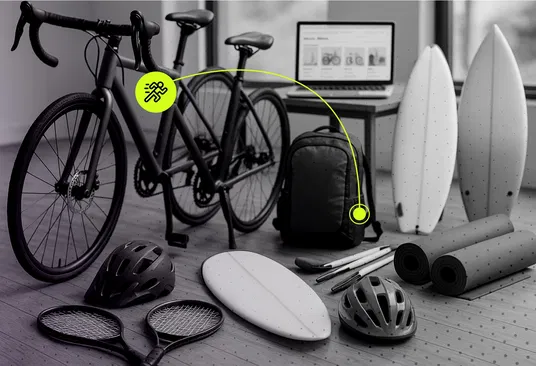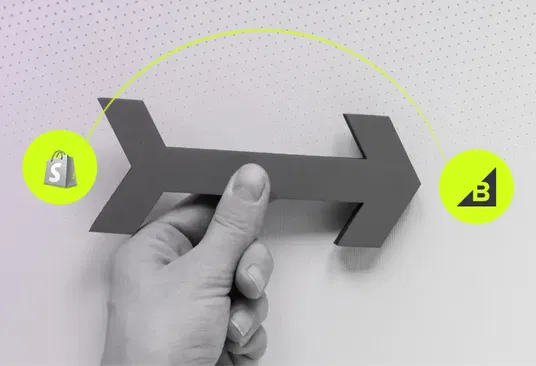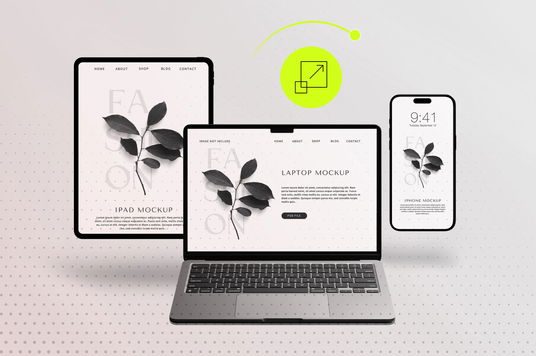The Rise of Rentals: Building a Sports Equipment Rental eCommerce Store

- The Rental Economy Revolution in Sports
- Market Opportunity & Consumer Behavior
- Sports Gear Rental Website Setup Essentials
- Calendar-Based Booking System
- Duration-Based Inventory Blocking for Rentals
- Deposit Workflows & Payment Processing
- Equipment Return Condition Tracking System
- Fulfillment Flow for Rented Outdoor Equipment
- Auto-Reminder System for Rental Returns
- Building a Bike/Kayak Rental eCommerce Experience
- Technical Architecture & Platform Selection
- Key Takeaways
- Frequently Asked Questions
The Rental Economy Revolution in Sports
The sports equipment rental market is experiencing unprecedented growth, driven by changing consumer preferences toward access over ownership. From weekend warriors seeking premium gear for occasional adventures to families looking for cost-effective ways to try new activities, the demand for sports gear rental website setup has never been higher.
This shift represents more than just a trend—it's a fundamental change in how consumers approach outdoor recreation and sports participation. Modern rental platforms are transforming the traditional retail model by offering flexible access to high-quality equipment without the burden of storage, maintenance, or depreciation.
Market Opportunity & Consumer Behavior
The rental economy in sports equipment is being driven by several key factors that create compelling opportunities for entrepreneurs and established retailers alike. Understanding these drivers is crucial for anyone looking to enter this rapidly expanding market.
"The average outdoor enthusiast uses specialized equipment only 12 days per year, yet spends thousands on gear that sits unused 97% of the time. Rental platforms solve this inefficiency while making premium equipment accessible to everyone." — Outdoor Industry Association, 2024 Participation Report
Key Market Drivers
Cost Consciousness
High-quality sports equipment can cost thousands of dollars. Rentals allow consumers to access premium gear at a fraction of the purchase price, making expensive activities more accessible.
Storage Limitations
Urban living spaces often lack storage for bulky equipment like kayaks, skis, or camping gear. Rentals eliminate the need for dedicated storage space.
Try Before You Buy
Consumers want to test equipment before making significant investments. Rental experiences often lead to informed purchase decisions.
Maintenance Avoidance
Sports equipment requires regular maintenance, repairs, and updates. Rentals transfer this responsibility to the provider.
Sports Gear Rental Website Setup Essentials
Creating a successful sports gear rental website setup requires careful planning and the right technical foundation. Unlike traditional eCommerce stores that focus on one-time transactions, rental platforms must manage complex workflows involving availability, bookings, deposits, and returns.
The foundation of any successful rental platform starts with understanding the unique requirements that differentiate it from standard retail operations. These systems must handle time-based inventory, condition tracking, and multi-step customer journeys that span weeks or months.
Core Platform Requirements
- Inventory Management System: Track individual items, their condition, maintenance schedules, and availability across multiple time periods.
- Booking Engine: Allow customers to select dates, view real-time availability, and reserve equipment with integrated calendar functionality.
- Payment Processing: Handle deposits, rental fees, damage charges, and refunds through a secure, automated system.
- Customer Management: Maintain detailed customer profiles, rental history, and communication preferences.
- Logistics Coordination: Manage pickup, delivery, and return processes with integrated scheduling and tracking.
Calendar-Based Booking System
The heart of any rental platform is its booking system. A well-designed calendar interface allows customers to easily select rental periods while providing real-time availability information. This system must seamlessly integrate with inventory management to prevent overbooking and ensure accurate availability display.
Modern booking systems go beyond simple date selection. They incorporate dynamic pricing based on demand, seasonal adjustments, and equipment-specific factors. The most successful platforms offer intuitive interfaces that make the booking process as simple as reserving a hotel room.
Real-Time Availability
Display accurate availability across all equipment categories with instant updates as bookings are made or cancelled.
Dynamic Pricing
Implement demand-based pricing that adjusts rates based on seasonality, equipment popularity, and booking duration.
Multi-Item Bookings
Allow customers to rent multiple items with different rental periods in a single transaction.
Booking Modifications
Enable customers to extend, shorten, or modify their rentals with automatic pricing adjustments.
Advanced Booking Features
Successful rental platforms incorporate advanced features that enhance the user experience and operational efficiency:
- Waitlist Management: Allow customers to join waitlists for popular items and automatically notify them when equipment becomes available
- Group Bookings: Handle large group reservations with special pricing and coordination features
- Recurring Rentals: Support customers who need equipment on a regular basis with subscription-like booking options
- Mobile Optimization: Ensure the booking process works seamlessly on mobile devices, where many customers make last-minute reservations
Duration-Based Inventory Blocking for Rentals
Duration-based inventory blocking for rentals is a critical component that prevents overbooking and ensures accurate availability display. This system must account for rental periods, buffer times for cleaning and maintenance, and transportation logistics.
Unlike traditional inventory systems that track simple quantities, rental inventory management must consider time as a dimension. Each piece of equipment exists in a specific state at any given time: available, rented, in maintenance, in transit, or damaged.
"Effective inventory blocking is the difference between a smooth operation and customer disappointment. Our system blocks equipment not just during rental periods, but also for the time needed to clean, inspect, and prepare items for the next customer." — REI Co-op, Rental Operations Manager
Inventory Blocking Strategies
Basic Blocking
- Simple date range blocking
- Manual buffer time addition
- No automated maintenance scheduling
- Risk of overbooking during transitions
Advanced Blocking
- Automated buffer time calculation
- Maintenance schedule integration
- Transportation time consideration
- Condition-based availability rules
Implementation Considerations
When implementing duration-based inventory blocking for rentals, consider these essential factors:
- Buffer Times: Account for cleaning, inspection, and preparation time between rentals
- Maintenance Windows: Schedule regular maintenance that automatically blocks equipment availability
- Seasonal Adjustments: Modify blocking rules based on seasonal demand and equipment usage patterns
- Emergency Reserves: Maintain a percentage of inventory as emergency backup for equipment failures
For businesses specializing in outdoor equipment, partnering with experts in sports & outdoor equipment eCommerce development services ensures your inventory blocking system is optimized for your specific equipment types and operational requirements.
Deposit Workflows & Payment Processing
Rental businesses require sophisticated payment processing that goes beyond simple transactions. Deposit workflows protect against damage and theft while providing customers with transparent pricing and clear expectations about charges.
A well-designed deposit system builds trust by clearly communicating all potential charges upfront and providing automated processing that minimizes manual intervention. This reduces operational overhead while ensuring consistent application of policies.
Deposit Structure Options
| Deposit Type | Amount | Best For | Customer Impact |
|---|---|---|---|
| Fixed Amount | $50-$200 | Low-value items | Predictable, easy to understand |
| Percentage-Based | 25-50% of item value | High-value equipment | Scales with equipment value |
| Tiered System | Varies by category | Mixed inventory | Balanced approach |
| Credit Card Hold | Full replacement value | Premium equipment | No upfront payment required |
Automated Deposit Processing
Modern rental platforms automate deposit handling to reduce manual work and improve customer experience:
- Pre-Authorization: Hold funds on customer credit cards without charging until damage assessment
- Automatic Release: Return deposits automatically when equipment is returned in good condition
- Partial Deductions: Process partial charges for minor damage with detailed explanations
- Dispute Management: Provide clear processes for customers to contest damage charges
Equipment Return Condition Tracking System
An equipment return condition tracking system is essential for maintaining inventory quality and ensuring fair damage assessments. This system documents equipment condition before and after each rental, providing objective evidence for any damage claims.
Effective condition tracking protects both the business and customers by creating transparent, documented processes that reduce disputes and ensure consistent equipment quality standards.
Photo Documentation
Capture detailed photos of equipment before and after each rental, with timestamp and GPS data for verification.
Condition Scoring
Use standardized scoring systems to objectively assess equipment condition and track degradation over time.
Damage Categories
Classify damage types with associated repair costs and customer responsibility levels.
Maintenance Triggers
Automatically schedule maintenance when equipment condition scores fall below thresholds.
Digital Inspection Workflows
Modern equipment return condition tracking systems leverage mobile technology to streamline inspections:
- Pre-Rental Inspection: Document baseline condition with photos and condition scores before customer pickup
- Customer Acknowledgment: Have customers review and approve condition documentation via digital signature
- Return Inspection: Compare returned equipment against baseline documentation using side-by-side photo comparison
- Automated Assessment: Use AI-powered image analysis to identify potential damage and flag items for detailed review
- Customer Communication: Automatically notify customers of any damage findings with photo evidence and cost estimates
Fulfillment Flow for Rented Outdoor Equipment
The fulfillment flow for rented outdoor equipment encompasses the entire customer journey from booking confirmation to equipment return. This complex process requires coordination between inventory management, logistics, customer service, and quality control teams.
Successful fulfillment operations balance efficiency with customer experience, ensuring equipment is delivered clean, functional, and on time while maintaining cost-effective operations.
Fulfillment Process Stages
Pre-Fulfillment
- Booking confirmation and payment processing
- Equipment allocation and availability verification
- Customer communication and expectation setting
- Logistics planning and route optimization
Active Fulfillment
- Equipment preparation and quality inspection
- Packaging and delivery coordination
- Customer handoff and instruction provision
- Real-time tracking and status updates
Delivery Models
Different delivery models serve various customer segments and operational requirements:
- Self-Pickup: Customers collect equipment from designated locations, reducing delivery costs
- Local Delivery: Direct delivery to customer locations within defined service areas
- Partner Locations: Equipment pickup from partner retailers or outdoor centers
- Event Delivery: Specialized delivery to event locations, campsites, or trailheads
The most successful rental operations offer multiple fulfillment options, allowing customers to choose based on their preferences and circumstances. This flexibility increases conversion rates and customer satisfaction while optimizing operational efficiency.
Auto-Reminder System for Rental Returns
An effective auto-reminder system for rental returns is crucial for maintaining inventory turnover and preventing lost equipment. These systems use multiple communication channels and escalation procedures to ensure timely returns while maintaining positive customer relationships.
Well-designed reminder systems balance persistence with customer experience, providing helpful reminders without becoming intrusive. They also integrate with inventory management to automatically update availability as returns are processed.
Reminder Timeline Strategy
7 Days Before
Friendly reminder with return instructions and location details. Include weather forecast and activity tips.
2 Days Before
Confirmation reminder with specific return time and location. Offer extension options if needed.
Day of Return
Final reminder with return checklist and contact information for any issues.
Overdue Escalation
Progressive escalation with late fees, phone calls, and eventual equipment replacement charges.
Multi-Channel Communication
Effective auto-reminder systems for rental returns use multiple communication channels to ensure messages reach customers:
- Email Reminders: Detailed messages with return instructions, maps, and contact information
- SMS Notifications: Brief, urgent reminders for day-of and overdue situations
- Push Notifications: In-app alerts for customers using mobile applications
- Phone Calls: Personal contact for high-value equipment or persistent overdue situations
Building a Bike/Kayak Rental eCommerce Experience
Building a bike/kayak rental eCommerce experience requires understanding the unique characteristics of these popular rental categories. Each equipment type has specific requirements for storage, maintenance, safety, and customer instruction that must be reflected in the platform design.
Successful bike and kayak rental platforms focus on location-based services, weather integration, and safety education while providing seamless booking and fulfillment experiences.
"Bike and kayak rentals are gateway activities that introduce people to outdoor recreation. Our platform design emphasizes safety education and confidence-building to ensure positive first experiences that create lifelong enthusiasts." — Adventure Outfitters Association, 2024 Industry Report
Bike Rental Specific Features
Size Matching
Advanced sizing algorithms that match customers with appropriate bike sizes based on height, inseam, and riding style preferences.
Route Integration
Integration with local trail maps and route planning tools to help customers plan their rides and estimate rental duration.
Accessory Bundling
Automatic suggestions for helmets, locks, lights, and other safety equipment based on rental duration and route selection.
Maintenance Tracking
Detailed maintenance logs tracking mileage, component wear, and service schedules to ensure safe, reliable equipment.
Kayak Rental Considerations
Kayak rentals present unique challenges that require specialized platform features:
- Weather Integration: Real-time weather and water condition monitoring with automatic booking restrictions during unsafe conditions
- Safety Briefings: Mandatory safety video completion and knowledge verification before equipment release
- Group Coordination: Tools for managing group rentals with different skill levels and equipment needs
- Launch Site Management: Integration with local launch sites, permits, and access restrictions
Technical Architecture & Platform Selection
Selecting the right technical foundation is crucial for rental platform success. The architecture must support complex inventory management, real-time availability, and integration with multiple third-party services while maintaining performance and scalability.
Modern rental platforms require robust backend systems that can handle high transaction volumes, complex business logic, and extensive integrations while providing fast, responsive user experiences across all devices.
Platform Architecture Components
Inventory Management
Real-time tracking of individual items, their status, location, and availability across multiple time periods.
Booking Engine
Calendar-based reservation system with dynamic pricing, availability checking, and conflict resolution.
Payment Processing
Secure handling of deposits, rentals, damage charges, and refunds with automated reconciliation.
Communication System
Automated messaging, reminder systems, and customer communication tracking across multiple channels.
Integration Requirements
Successful rental platforms integrate with numerous external services:
- Payment Gateways: Stripe, PayPal, or similar for secure payment processing
- Communication Services: Twilio for SMS, SendGrid for email, push notification services
- Mapping Services: Google Maps or Mapbox for location services and route planning
- Weather APIs: Real-time weather data for safety and operational decisions
- Accounting Systems: QuickBooks or similar for financial management and reporting
When building complex rental platforms, working with experienced developers who understand the unique requirements of sports & outdoor equipment eCommerce development ensures your platform can handle the technical challenges while providing excellent user experiences.
Key Takeaways
The sports equipment rental market represents a significant opportunity for entrepreneurs and established retailers willing to embrace the complexity of rental operations. Success requires careful attention to inventory management, customer experience, and operational efficiency.
Essential Success Factors
- Implement robust sports gear rental website setup with calendar-based booking systems
- Deploy comprehensive equipment return condition tracking systems to protect inventory and customer relationships
- Utilize duration-based inventory blocking for rentals to prevent overbooking and optimize utilization
- Design efficient fulfillment flows for rented outdoor equipment that balance cost and customer experience
- Implement effective auto-reminder systems for rental returns to maintain inventory turnover
- Focus on specialized experiences like building bike/kayak rental eCommerce experiences that address specific equipment needs
- Choose technical architectures that support complex rental workflows and integrations
- Prioritize customer education and safety to build trust and encourage repeat business
Frequently Asked Questions
1. What are the most important features for a sports equipment rental website?
The most critical features include real-time inventory management with calendar-based booking, automated deposit processing, comprehensive condition tracking systems, multi-channel reminder systems, and mobile-optimized interfaces. These features ensure smooth operations while providing excellent customer experiences.
2. How do I prevent equipment damage and theft in rental operations?
Implement comprehensive deposit systems, detailed condition tracking with photo documentation, customer education programs, and clear damage policies. Use credit card pre-authorization for high-value items and maintain insurance coverage for theft and major damage incidents.
3. What's the best way to handle seasonal demand fluctuations?
Use dynamic pricing that adjusts based on demand, implement waitlist systems for popular periods, offer off-season promotions, and consider partnering with complementary businesses to maintain year-round revenue. Flexible inventory management allows you to adjust equipment mix based on seasonal patterns.
4. How can I optimize my rental fulfillment process?
Offer multiple fulfillment options (pickup, delivery, partner locations), use route optimization software for deliveries, implement mobile inspection tools, and automate as much of the process as possible. Focus on clear communication and setting proper expectations with customers.
5. What technical platform is best for rental businesses?
Choose platforms that support complex inventory management, time-based bookings, and extensive integrations. Custom solutions often work best for established businesses, while SaaS rental platforms can be good starting points for new operations. Consider scalability, integration capabilities, and ongoing support when making decisions.
Ready to Choose the Right Development Partner?
Building a successful sports equipment rental platform requires expertise in complex inventory management, booking systems, and customer experience design. Our team specializes in creating rental-ready eCommerce solutions that handle the unique challenges of equipment rental businesses.
Get Your Free ConsultationAbout 1Center
1Center specializes in developing high-performance eCommerce solutions for sports and outdoor equipment businesses. Our team combines deep industry knowledge with cutting-edge technology to create rental platforms that drive growth and operational efficiency. From complex inventory management to seamless customer experiences, we help sports equipment businesses build platforms that scale with their success.
Get Expert Sports Equipment eCommerce Consultation >Written byPublished July 11, 2025
1Center


